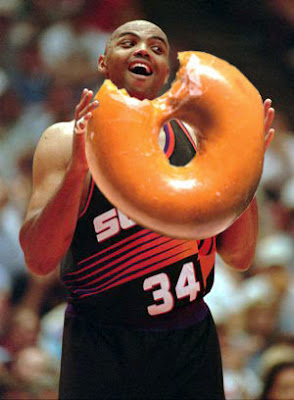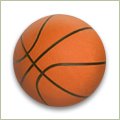
In this age of obesity, it's comforting to know that most serious basketball players have relatively low body fat percentages. Unlike some sports (football linemen, sumo wrestling) where extra pounds help you keep your position, basketball simply requires so much running, jumping, and change of direction, that being obese is simply not acceptable.
Even those players whom we think of as fat, are only relatively so. Charles Barkley (above) is a good example:
In a Sports Illustrated article from 1984, his preseason fitness testing before his Junior year revealed his body fat percentage to be 14.5%. The average adult male ? 15-18 %
Now I'm not saying that Sir Charles didn't like to eat (see ginormous Krispy Kreme above), but his girth was always compared to his ectomorphic (look it up) basketball playing peers.
And yes, even professional basketball players can gain too much weight for their own good
(Charles to super-sized Oliver Miller - "You can't even jump high enough to touch the rim, unless they put a Big Mac on it" or Charles to Stanley Roberts: "Hey Stanley, you could be a great player if you learned just two words: I'm full.") . But players have learned the importance of keeping lean, and players who want to make an NBA-roster have learned how to keep their body fat percentage down.
Body fat % has been part of the NBA Draft Combine since 2003. Back when it first began to be measured, more than 1/3 of would-be draft picks at the combine had body fat percentages of 10% or higher, and a few players actually showed up with body fat percentages over 20% (don't think they had very long NBA careers).
These days, the body fat percentage at combine is much lower, with only 7 of the 50 players showing 10% or more (and the highest was AJ Price at 12.4%) at the 2009 event.
So here's another reason to play basketball -- participation and success often go hand in hand with healthy weights (even if you eat the ocassional donut).














